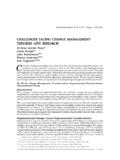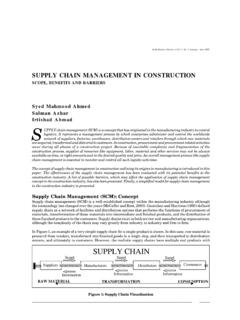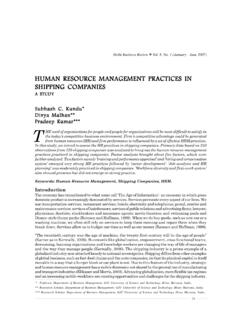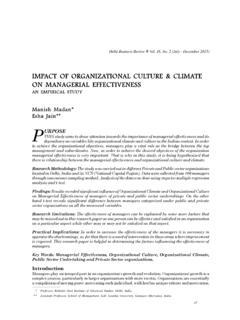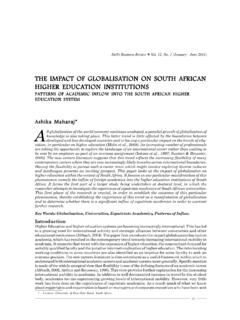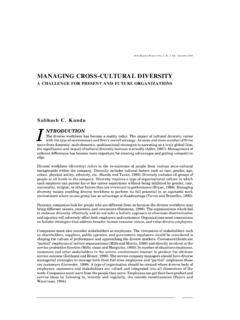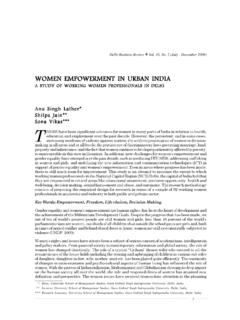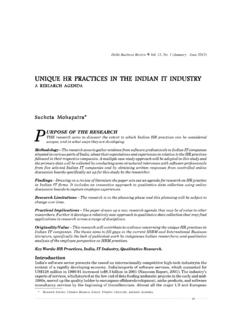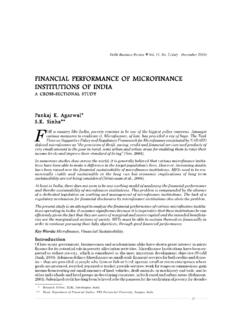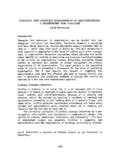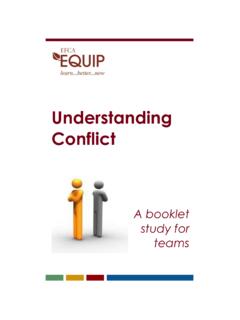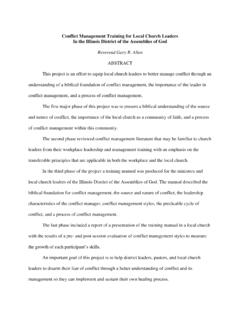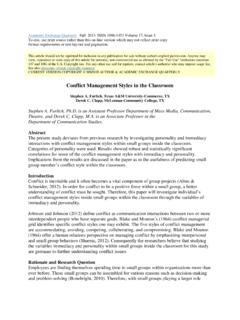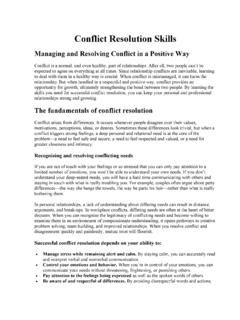Transcription of CONFLICT MANAGEMENT IN TEAMS
1 1 Delhi Business Review X Vol. 7, No. 2, (July - December 2006)IHE key issue in dealing with team CONFLICT is for the team to realize that the focus is not onconflict itself, but how it is managed. The consequences of poorly handled team CONFLICT resultlowering of team energy, disruption of healthy relationships, and the prevention of job accomplish-ment. Certain causes for team CONFLICT include, perceived breach of faith; unresolved disagreement,miscommunication, personality clashes, differences in acquired values, underlying stress and tension,ego problems, etc. Certain curing measures for the resolution of conflicts are improved communicationskills, team counseling, relinquishing, accommodating, collaborating, listening, responding, understanding , etc.
2 Key guidelines for avoiding or resolving team conflicts include, reaching consensusthrough collaboration, controlling emotional outburst, enhance self-esteem, preserve individual dignity,listen carefully and with empathy, be honest about concerns, get individual ego out of managementstyle, etc. Valuable suggestions to resolve conflicts are: training on the human dynamics of workingtogether, gain alignment around core team processes, develop a CONFLICT resolution process, keepdisagreement from escalating into CONFLICT , develop a relationship with difficult team members, pervades the core of team processes, and, if un-addressed, CONFLICT serves to stunt the developmentof a consist of a small group of people with complementary skills who are committed to a commonpurpose, goals and approach for which they hold themselves mutually accountable.
3 (Katzenbach andSmith 1993). When a team is formed, its members must have the right mix of complementarycompetencies to achieve the team s goals. Also, its members need to be able to influence how they willwork together to accomplish those goals (Syer 1997). TEAMS create synergy, that is, the sum of theefforts of team members is far greater than the sum of the individual efforts of people working alone(French et al. 2007). TEAMS must learn to be confrontational without destroying the team indicates that high performing TEAMS are capable of mediating their own conflicts whileimproving productivity and strengthening relationships (McDaniel et ). Individual employeesperform operating tasks, but the vast majority of them work in regular small groups where theirefforts must fit together like the pieces of a picture puzzle.
4 Where their work is interdependent, they actas a task team and seek to develop a cooperative state called teamwork. (John and Keith, 1995). Teamworkis the ability of a group of people to cooperate and work effectively together, the possibility of eachparticipant to think and act for the group rather than for his own personal benefit (Singh, 2004). CONFLICT is a driving force of change (McDaniel et ). When managed correctly, CONFLICT producesnew ideas for changing organizational processes, solving of continuous problems, a chance for workersto expand their capabilities, and the introduction of creativity into thoughts about organizational problemsTCONFLICT MANAGEMENT IN TEAMSCONFLICT MANAGEMENT IN TEAMSCONFLICT MANAGEMENT IN TEAMSCONFLICT MANAGEMENT IN TEAMSCONFLICT MANAGEMENT IN TEAMSCAUSES & CURESCAUSES & CURESCAUSES & CURESCAUSES & CURESCAUSES & CURESAjaAjaAjaAjaAjay Kry Kry Kry Kry Kr.
5 Sin. Sin. Sin. Sin. Singh*gh*gh*gh*gh*DDDDD. Anton. Anton. Anton. Anton. Antony**y**y**y**y**Reader, Department of Commerce, Delhi School of Economics, University of Delhi, Delhi.**Programme Director- MANAGEMENT Studies, Tecnia Institute of Advanced Studies (Affiliated to GGS Indraprastha University, Delhi), Kr. Singh and D. Antony2(Bowditch & Buono, 1997). The consequences of poorly handled team CONFLICT result lowering of teamenergy, disruption of healthy relationships, and the prevention of job accomplishment. The key issue indealing with team CONFLICT is for the team to realize that the focus is not on CONFLICT itself, but how it ismanaged.
6 The idea behind managing CONFLICT is not to reduce CONFLICT , but to handle it in a constructivemanner (Rayeski & Bryant, 1994). Too often, CONFLICT is smoothened over by a team leader and is notresolved; the end result is a building up of resentment between team members that deteriorates theteam s performance level (Wisinski, 1995). team CONFLICT CONFLICT is a word that causes a great degree of discomfort, anger, frustration, sadness, and pain topeople. In the workplace, a simple disagreement between team members, if unresolved, may escalateinto avoidance, inability to work together, verbal assaults, and resentment. In the worst cases, it mayalso lead to hostility and eventual separation from the organization.
7 Therefore, it is important that theconflict be resolved as soon as possible. ( team Problem Solver). CONFLICT is a struggle to resist orovercome; a contest of opposing forces; strife; battle; a state or condition of opposition; antagonism;discord; clash; collision. CONFLICT arises from a multitude of sources that reflect the differences inpersonality, values, ideologies, religion, culture, race, and behavior. It also arises from simplemisunderstandings. As we have expanded collaborative concepts within our workplaces, we havedramatically increased the number of human interactions where one s opinions can be heard. Newteams, for example, may find themselves in CONFLICT as discussions lead them into uncharted waters(Peter B.)
8 Grazier).Source of ConflictUse of common resources-In the company sales offices where the institutional and retail sales teamscoexist, they share the same godown or C & F (Clearing & Forwarding) agent, billing system, commercialteam, delivery team and the accounting department. Both the TEAMS want a priority treatment to theirown customers or channel members. They try to expert pressure on billing people and delivery staff toexecute their orders immediately even if it may result in more cost to the company by way of smalldelivery loads or multiple consignments towards the same geographical area. The commercial team ,always under pressure to reduce operating costs, tries to optimize the use of space in any carrier andclub the supplies in one direction.
9 Obviously, this leads to some unexecuted orders at any point of time,leading to friction in the sales TEAMS . This problem magnifies at the sales closing stage every monthwhen all the sales team members extract orders from each channel partner or customer to fulfill theirtargets. Each one of them wants that at any cost, the orders procured by him should be billed anddelivered before the sales is closed by the commercial department. Though this situation arises evenwhere there is only one type of sales team , somehow it is more evident where both the TEAMS areworking. Probably, this is due to the existence of two team leaders, which gives a feeling of our salesand their sales in the two groups (Zameer 2005).
10 team CONFLICT can be a source of excellence, quality and creativity. However, occasions can arise whereconflict in TEAMS becomes interpersonally destructive and leads to lowered effectiveness. This occursespecially where the CONFLICT takes on a personal quality, which results in team members attacking oneanother, or denigrating each other s skills, abilities or functioning in some way. This is unhealthy bothfor the individuals, concerned and for the team as a whole. Interpersonal conflicts are often not causedby the personalities of the individuals involved, but by work role or organizational factors. There is atendency to attribute to individual s problems, which may be due to factors in the work causes of interpersonal CONFLICT in TEAMS can often be due to broader organizational problems suchas lack of structure, inadequacy of resources, poor organizational climate or inappropriate organizationalstrategy.
